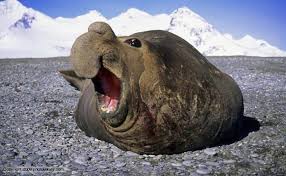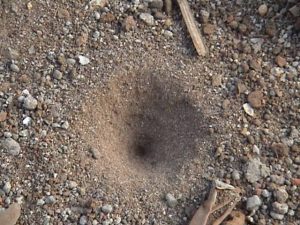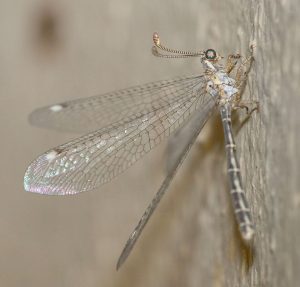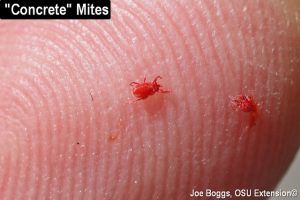Podcast: Play in new window | Download (Duration: 8:21 — 9.2MB)
Thanks to Jayson and warblrwatchr for suggesting this week’s invertebrates!
Further reading:
Parasite of the Day: Orthohalarachne attenuata
Trap-jaw ants jump with their jaws to escape the antlion’s den
Get out of my noooooose:

An ant lion pit:

An ant lion larva:

A lovely adult antlion, Nannoleon, which lives in parts of Africa [photo by Alandmanson – Own work, CC BY-SA 4.0, https://commons.wikimedia.org/w/index.php?curid=58068259]:

Show transcript:
Welcome to Strange Animals Podcast. I’m your host, Kate Shaw.
It’s almost August, and of course we’re doing invertebrate August again this year. Let’s get ready by talking about a few extra invertebrates this week, with suggestions from Jayson and warblrwatchr.
Before we get started, I have some quick housekeeping. First, a big shout-out to Nora who emailed me recently. I just wanted to say hi and I hope you’re having a good day. Next, I’m moving in just a few weeks to Atlanta, Georgia! I know I was talking forever about moving to Bloomington, Indiana, but I changed my mind. The next few episodes are already scheduled so I can concentrate on moving.
I’m about 75% packed at this point and have given away or sold a lot of stuff, including a lot of books. But I have a collection that a listener might be interested in. I offered it to the patrons last month but no one grabbed it, so I’ll offer it here.
I have every issue of the little magazine Flying Snake ever published, 30 in all. They’re a fun hodgepodge of articles, reprinted newspaper clippings, old photos, and other stuff more or less associated with cryptozoology and weirdness in general. I’ve decided they take up too much space on my shelves to take with me to Atlanta. If you’re interested in giving them a home, let me know and I’ll box them up and send them to you for free. The first person who says they’ll take them will get them, but the catch is that you have to take them all. I won’t just send you a few. I’ll also throw in all four volumes of the Journal of Cryptozoology. This offer stands until mid-August when I move, because if I have to move them to my new apartment, I’m just going to keep them.
Okay, now let’s learn about some invertebrates! First, Jayson wanted to learn about a tiny invertebrate called Orthohalarachne attenuata. It doesn’t have a common name because most people will never ever encounter it, or think about it, and I kind of wish I didn’t have to think about it because it’s gross. Thanks a lot, Jayson. It’s a mite that lives in the nasal passages of seals, sea lions, and walruses. It’s incredibly common and usually doesn’t bother the seal very much, although sometimes it can cause the seal to have difficulty breathing if the infestation is heavy.
The adult mite spends its whole life anchored in the seal’s nasal passages with sharp little claws, although it can move around if it wants to. Its larvae are more active. The mite is mainly spread by seals sneezing on each other, which spreads the larvae onto another seal, and the larvae crawl into the new seal’s nose and mouth.
Unless you’re a seal or other pinniped, this might sound gross but probably doesn’t bother you too much. But consider that in 1984, a man went to the doctor when one of his eyes started hurting. The doctor found a mite attached to his eyeball, and yes, it was Orthohalarachne attenuata. The man had visited Sea World two days before he started feeling pain in his eye, and happened to be close to some walruses that were sneezing.
Luckily for pinnipeds kept in captivity in zoos that give their animals proper care, mite infestations can be treated successfully by veterinarians.
Let’s move on quickly to an invertebrate that isn’t a parasite that can get in your eyes, the ant lion! It was suggested by warblrwatchr and I’ve been wanting to cover it for a while. When I was a kid, there was a strip of soft powdery dirt under the eaves of the school gym that always had ant lions in it, and I would squat down during recess and watch to see if any ants would fall in and get caught. Sometimes this did actually happen and the resulting battle between ant and ant lion was exciting and kind of horrible to witness.
The ant lion is actually the larva of antlion lacewing, which look like a small damselfly that is mainly active at dusk. Ant lions live throughout the world, with more than 2,000 species known. Some wait for prey while hidden in leaf litter, while some hide in rock crevices and become camouflaged by lichens growing on them. Many others dig little pits in sand or soft dirt. They’re also called the doodlebug in some places, because when they’re looking for a place to dig a little pit, they make a loopy pattern in the dirt as they’re walking around.
The ant lion’s body is robust and has little backwards-pointing bristles that help it dig itself into the dirt and stay there without moving until it needs to. It waits at the bottom of the pit, hidden underground with just its long, sharp jaws showing through the dirt, until an ant or other insect falls in. The ant can’t climb out because the sides of the pit are so sharply angled that they start to cave in, sending the ant down to the bottom of the pit. If that doesn’t work, the ant lion kicks dirt at the ant so that it falls. Then the ant lion grabs the ant in its fearsome jaws and injects venom and digestive enzymes into it, and that is the end of the ant. The jaws actually have little projections that are hollow and act like horrible little straws, so that the ant lion sucks the liquefied ant insides into its digestive system.
One species of ant, the trap-jaw ant, can sometimes escape the ant lion’s pit by using its own fearsome jaws as a spring to bounce itself to safety. There are many species of trap-jaw ant that live in tropical and subtropical areas throughout much of the world, including Africa, Asia, Australia, and much of the Americas. Its long jaws can snap closed extremely quickly and with a lot of force, allowing it to kill prey, bite pieces off of food, and lots of other activities. They can also jump with their jaws, and this improves their ability to bounce right out of the ant lion pit.
The ant lion can remain in its larval stage for years, maturing slowly. It has no anus but it doesn’t expel the waste products that it can’t digest, it just stores them in its body. When it does finally pupate, it uses a lot of the waste to produce silk for its cocoon. Whatever is left over it leaves behind when it emerges from its cocoon.
The cocoons are naturally hidden underground, and when the adult antlion lacewing emerges, it digs its way to the surface and rests while its wings open. Compared to the tough little larva, the adult is delicate and not very robust. It doesn’t live very long, usually no more than a few weeks, and most species eat pollen or nectar, or maybe tiny insects. It mainly just seeks out a mate, and the female lays her eggs in soft soil. When they hatch, they build their first tiny pits and the cycle starts again. And nobody gets into anybody’s eyeballs.
You can find Strange Animals Podcast at strangeanimalspodcast.blubrry.net. That’s blueberry without any E’s. If you have questions, comments, or suggestions for future episodes, email us at strangeanimalspodcast@gmail.com. We also have a Patreon at patreon.com/strangeanimalspodcast if you’d like to support us for as little as one dollar a month and get monthly bonus episodes.
Thanks for listening!

